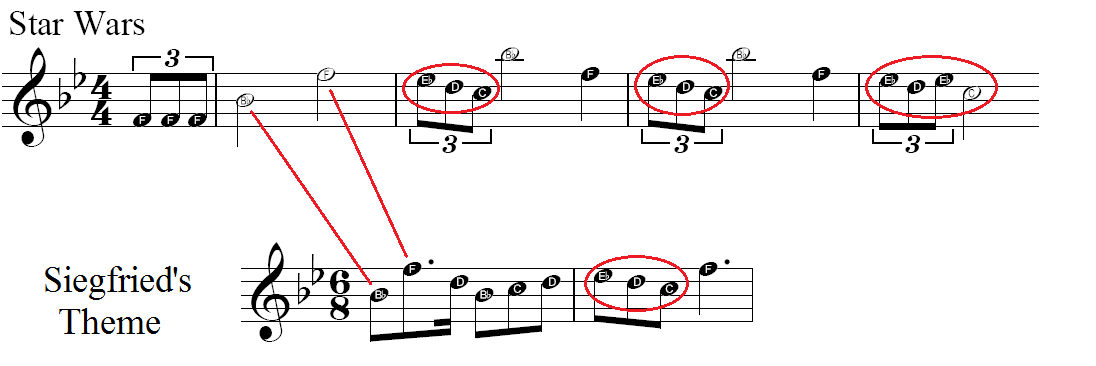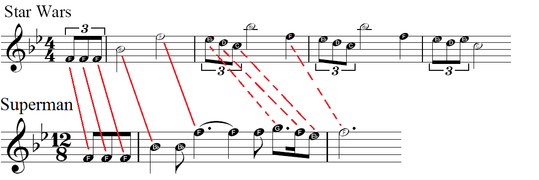|
The jaunty and primitive "Parade of the Ewoks" contrasts strongly with the more sophisticated music of the other characters (though it is somewhat comparable to the jawa music from A New Hope), and bears similarities to Sergei Prokofiev's "March" from The Love of Three Oranges. The two are clearly not identical, or even near-identical (as was the case between the Star Wars Main Theme and King's Row), but there is indeed a strong resemblance. First of all, the melodies use similar pitches. For the sake of comparison, in the examples below the "Parade of the Ewoks" has been transposed to match the "March". The red lines, then, indicate identical pitches. Both the Williams and the Prokofiev use A flat frequently, and play with the note C - sometimes it's C natural, other times it's C flat. There are rhythmic similarities, as well. The rectangles in the example below show identical rhythms between the two. In addition, both excerpts conclude with a long(er) held and relatively low note, illustrated with the dotted line. Although the above illustrations only includes the first two phrases of both pieces, the similarities do continue further in. The primary melody of the "Parade of the Ewoks" is answered by a trumpet fanfare that also resembles the Prokofiev, as illustrated below. In this case, there are no definite pitches to cite, but the intervals are comparable, the rhythms are again similar, and the melodic contour very similar.
The strongest relationship, however, is not in pitches nor rhythm but rather in character - both are rather ridiculous marches (the score for "Parade of the Ewoks" is marked "A la marcia") that share tempi and border on absurdity. Orchestrationally, too, the comedy of both is heightened by the prominent use of the piccolo. While not as evident as some other Star Wars borrowings, there are undeniable similarities between "Parade of the Ewoks" and the march from The Love of Three Oranges. With that in mind, it's a pretty safe bet that George Lucas included the latter on his temp track for Return of the Jedi.
1 Comment
Although Return of the Jedi used a wordless male chorus to enhance The Sith Theme, The Phantom Menace was the first Star Wars film to feature music with sung lyrics.
John Williams: "The great sword fight at the end of the film - the decision to make that choral was just the result of my thinking that it should have a ritualistic or quasi-religious feeling, and the introduction of a chorus might be just the thing. ... [T]he medium of chorus and orchestra would give us a sense that we're in a big temple." Here are the lyrics in full: Korah Matah Korah Rahtahmah Korah Rahtamah Yoodhah Korah Korah Syahdho Rahtahmah Daanyah Korah Keelah Daanyah Nyohah Keelah Korah Rahtahmah Syadho Keelah Korah Rahtahmah Korah Daanyah Korah Rahtahmah Korah Daanyah Korah Rahtahmah Nyohah Keelah Korah Rahtahmah Syadho Keelah Korah Rahtahmah Korah Korah Matah Korah Rahtahmah Korah Daanyah Korah Rahtahmah Nyohah Keelah Korah Rahtahmah Syadho Keelah Korah Rahtahmah Korah These words originated in the medieval Welsh poem Cad Goddeu (The Battle of the Trees). The text was translated into English by Robert Graves, and published in 1948 as part of The White Goddess: A Historical Grammar of Poetic Myth. John Williams selected lines 32-35: Under the tongue root a fight most dread, and another raging behind in the head I have absolutely no idea what any of the original text means, but Williams had it translated into a variety of languages, eventually selecting Sanskrit "because of the quality of the vowels". If we read between the lines, then, John Williams liked the Sanskrit because it helped provide that "ritualistic or quasi-religious" character that was missing from other languages (and, no doubt, English in particular). As a sci-fi epic, Star Wars has appropriately adventurous and heroic music - particularly the main theme, which uses several music tricks to help establish that heroic quality.
The use of an ascending perfect fifth and triplets has a strong precedent in Richard Wagner's Ring Cycle, particularly in the third opera, Siegfried, which feature's the leitmotif known as "Siegfried's Theme" very prominently. In 1978, one year after the release of Star Wars: A New Hope, John Williams scored Superman and wrote a theme that bears strong similarities to the Star Wars Main Theme. Both feature very similar openings, with triplet pick ups on scale degree 5 followed by an ascending perfect fifth from 1 to 5; both employ comparable (though hardly identical) triplets. These similarities are no surprise, as both tunes needed such heroic qualities.
|
The Music of Star WarsThese posts will help focus and develop my analyses of John Williams' film scores. Archives
December 2019
Categories
All
|






 RSS Feed
RSS Feed
